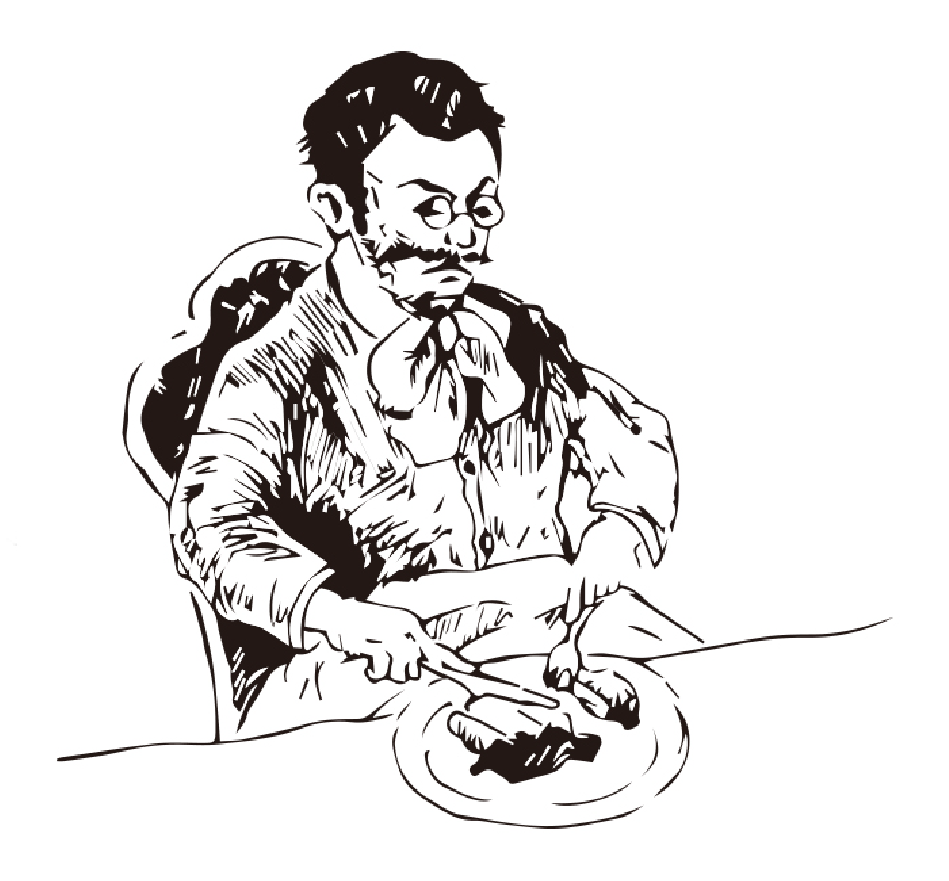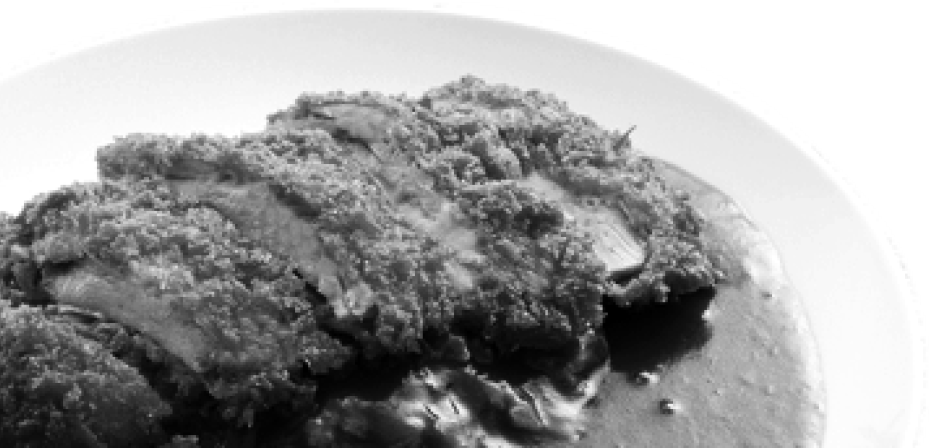

Sauce and “tonkatsu”
have an inextricable relationship.
“Tonkatsu” continues to be beloved by
Japanese people just as it was long ago.
So where did “tonkatsu” come from?
How do you prepare delicious “tonkatsu”?
Allow us to tell you everything you
thought you knew about “tonkatsu.”
Introduction
Japan has only been consuming meat for about 150 year ens, which is not a very long time. This is believed to be because Emperor Tenmu issued a ban on hunting and fishing, which made it illegal to consume meat for the 1200-year en stretch between the Asuka period and the Bakumatsu period.
Upon entering the Meiji period, Japan set out on the path to modernization in order to match the Western powers. This resulted in the rapid influx of Western culture, which in turn ushered in a renaissance in food culture due to the influence of Western cuisine. The Meiji emperor himself advocated the consumption of meat, and once it was no longer taboo, seasonings and spices that complemented the taste of meat (such as sauces) began to be brought in from the West. While agriculture had a strong cultural foundation, the proliferation of Western eating habits led to a rise in livestock cultivation, and this would lead to Japan making its own innovations on Western cuisine—the very innovations that now grace dining tables throughout the country.

Beginning of
the Edo Period
Knowledge of pork makes its way to Satsuma province via the Ryukyu Islands, which learned of it from China.
Sauce
In French and Italian cuisine, among others, each dish is served with a sauce used to accentuate the unique qualities of its ingredients. During the Bourbon dynasty (1589-1830) in particular, French cuisine came into its own, and it is said that béchamel sauce and demiglace sauce, two staples of French cuisine, were invented during this period.
Additionally, throughout Europe, various families and regions added spices and seasonings to adjust the recipes to their liking and adapt them for local dishes.

1869
A semi-governmental food company known as the “Gyuba Company” is founded and begins the sale of meat.
1870
Around the same time as the establishment of the “Gyuba Company,” Fukuzawa Yukichi published a pamphlet entitled “Nikujiki no Setsu” (An Argument for Eating Meat), in which he recommended meat consumption to the masses.
Sauce
Some say Worcestershire sauce was introduced toward the end of the Edo period, but knowledge of the sauce itself is thought to have begun due to contact with foreigners visiting Japan between the Bakumatsu period and the Meiji Restoration. During the Rokumeikan period in particular, a time characterized by Westernization, Worcestershire sauce started being used in Western-style restaurants in Tokyo, Yokohama, Kobe, and elsewhere along with new food products such as Western-style sweets, butter, and cheese.

1872
Within just five years of the beginning of the Meiji period, Japan underwent a major transformation. Edo was renamed Tokyo.
Within just five years of the beginning of the Meiji period, Japan underwent a major transformation. Edo was renamed Tokyo, universities began to be constructed in several cities, telegraph service was established between Tokyo and Yokohama, the House of Representatives was established, the Ministry of Engineering was created, a delegation was dispatched to Europe and America, a female student was sent to study in America, a teachers college opened in Tokyo, and a railway was opened between Shimbashi and Yokohama, among many other developments. Japan was determined to catch up to its Western counterparts.
Against this backdrop of change, the ban on the consumption of beef, horsemeat, poultry, and other meats persisted, and many ordinary people were hesitant to break with tradition. But this year, with the push towards becoming a “civilized nation,” Emperor Meiji himself ate beef for the first time, and the ban on meat consumption was officially lifted.
In the same year, Robun Kanagaki’s “Seiyo Ryoritsu” (Western Gourmet) and Shujin Keigakudo’s “Seiyo Ryori Shinan” (Lessons in Western Cuisine) were published as the first Western-style recipe books in Japan. Contained in “Seiyo Ryori Shinan” were instructions for making Western-style sauce, with the description reading, “This is soy sauce. It is more flavorful than the soy sauce in our country. I recommend using imported sauce.” This sauce was apparently assumed to be western soy sauce, though it remains unclear what kind of sauce it actually was.

1873
The Tondenhei system was implemented, which began the development of Hokkaido and would later become the foundation of onion and potato cultivation, ingredients essential to Western cooking.
1876
In 1872, the Hotel Seiyoken opened in Tsukiji. Later on, around the time Ueno Park opened, a branch of Seiyoken opened in Ueno and served as a trailblazer in French cuisine. During the Rokumeikan period, this became a lively social gathering spot for the royalty, nobility, and elite members of society, and it sometimes hosted conferences of historical significance. It should be noted that the first Western-style restaurant in Japan is believed to have been the restaurant “Ryorintei” in Nagasaki, which opened in 1863.
Sauce
The seventh owner of Yamasa Soy Sauce, Gihei Hamaguchi, was studying in America in 1884 and noticed that Worcestershire sauce was being sold in bottles. The eighth-generation owner then began researching and created a new type of sauce.
This sauce, called “Mikado Sauce,” was bottled in glass bottles and sent to San Francisco. It was marketed domestically as a “new type of soy sauce,” but many people didn’t find the taste appealing, so production was ceased within about a year.
However, with the rapid spread of Western cuisine, the quest for a sauce produced domestically that appealed to Japanese people’s tastes continued.
Seven years after the discontinuation of Mikado Sauce:
■1894: “Mitsuya sauce” is created (Echigoya: Kojiro Nunotani)
■1896: “Ikari-jirushi sauce,” now “Ikari sauce,” is created (Yamashiroya: Kojiro Kimura)
■1898: “Shirodama sauce” (Nomura Yoshokuryohin Seizojo: Senji Nomura)
In the Kanto area:
■1900: “Yaguruma sauce” (Itokochoen: Mr. Hasabe)
■1905: “Inujirushi sauce,” now Bull-Dog sauce (Misawaya Shoten: Nakasaburo Kojima)
■1906: “MT Omachi sauce” (Omachi Nobu)
■1912: “Swan sauce,” now Chicken sauce (Chojiro Arai)
went on sale.
In the Chubu region:
■1908: “Kagome Sauce” (Aichi Tomato Sauce Seizo, now known as Kagome: Ichitaro Kanie)
went on sale.
During the latter half of the Meiji period, a wide variety of sauces were invented all over the country, and Japan’s sauce industry rose to prominence.


1895
The last volume of the aforementioned recipe book “Seiyo Ryoritsu” published in 1872 included an entry for “hork cutlets.” “Hork” means “pork.” An examination of the recipe reveals that it called for frying pork in butter, which is similar to modern sautéed pork. This makes it different than the breaded and fried pork cutlets that we are familiar with.
The last volume of the aforementioned recipe book “Seiyo Ryoritsu” published in 1872 included an entry for “hork cutlets.” “Hork” means “pork.” An examination of the recipe reveals that it called for frying pork in butter, which is similar to modern sautéed pork. This makes it different than the breaded and fried pork cutlets that we are familiar with.
The one who came up with the idea to cover these pork cutlets in bread crumbs and deep-fry them was the founder of longstanding Ginza restaurant “Rengatei,” Motojiro Kida.
The restaurant was founded in 1895, and it was four years later that it began serving pork cutlets similar to what we have now.
At the time, they made cutlets by sautéing slices of meat one by one and then heating them in an oven, a pretty labor-intensive process. They were also pretty fatty, which did not appeal to Japanese customers.
To address this problem, Kida took a hint from tempura and had the idea to coat the cutlets in flour, beaten egg, and uncooked panko breadcrumbs, then fry them in plenty of oil for a crispy finish. This allowed two or three cutlets to be fried at once, and instead of serving steamed vegetables with the cutlets, which had been standard up until then, he had the idea of serving shredded cabbage instead. This had the advantage of being easier to prepare as well as providing a refreshing complement to the meat. Thus was born the famous combination of pork cutlets and cabbage, and it became one of Rengatei’s famous dishes, eventually spreading all over the country.

1900
The Ministry of Agriculture and Commerce imported sire pigs from America and England, helping to turn hog raising into a full-fledged industry.
1904
Worcestershire sauce is an essential complement to tonkatsu and Western cuisine. And the first recipe to appear in Japan was published in “Katei Jitsuyo Saishin Wayo Ryori” (The Latest in Practical Japanese-Western Home Cooking).
In Kazuhiro Ono’s “Meiji, Taisho, Showa no Recipe de Shoku Doraku” (The Pleasures of Meiji, Taisho, and Showa Recipes), he reproduced this Worcestershire sauce recipe. The author comments, “This sauce has a taste unlike anything you’ve ever experienced.” The recipe called for using soy sauce, vinegar, onions, ginger, brown sugar, pepper, and salt, and it used no spices or fruits. Considering the times, perhaps this could not be helped.
1907
Thanks to the invention of the pork cutlet at “Rengatei” in Ginza, the dish begins to take off in popularity.
Sauce
As Worcestershire sauce began being produced and sold throughout the country and became familiar to Japanese people, it became synonymous with sauce itself, and other Western condiments began to be used as well.
During the Taisho period, as tonkatsu and fried dishes became popular among the common people, the start of WWI ushered in a boom for sauce producers. Around this time, soy sauce producers turned their attention to sauces used as condiments and began investing in new sauce production, with big cities at the epicenter. The proliferation of ingredients and the incentive of competition resulted in a remarkable increase in both the quality and quantity of sauces available.



1910
In “Guntai Ryoriho” (Army Cooking), the official recipe book of the army, cutlets are one of the many meat dishes featured.
1918
The restaurant “Kawakin” in Asakusa, Tokyo (with headquarters currently in Shitaya) begins serving “Katsu curry” (curry with pork cutlet).
1921
“Katsudon” (pork cutlet rice bowl) is invented at the restaurant “Sanchoan” in Waseda.
1929
The word “tonkatsu” originated from the word “katsuretsu” (cutlet), which comes from the cutlets used in French cuisine. It is believed that once pork started being used to make pork cutlets, “ton,” which is the Chinese reading of “buta” (pork), started being used instead of “pork,” and thus the word “tonkatsu” was born.
From the end of the Meiji period to the Taisho period, pork cutlets became a staple of many Western-style restaurants. But when did this transition to “tonkatsu”?
The word “tonkatsu” originated from the word “katsuretsu” (cutlet), which comes from the cutlets used in French cuisine. It is believed that once pork started being used to make pork cutlets, “ton,” which is the Chinese reading of “buta” (pork), started being used instead of “pork,” and thus the word “tonkatsu” was born.
From the end of the Meiji period to the Taisho period, pork cutlets became a staple of many Western-style restaurants. But when did this transition to “tonkatsu”?
Movie director Kajiro Yamamoto offers an interesting take, making the distinction between pork cutlets and tonkatsu clear in his book “Nihon Sandai Yoshokuko” (Japan’s Three Major Western Dishes). This is what he says: “Regarding the differences between pork cutlets and tonkatsu, pork cutlets are thin, covered in Worcestershire sauce, and eaten with a knife and fork, whereas tonkatsu is thick, covered in tonkatsu sauce, cut into slices, and eaten with chopsticks.”
It is believed that thickly sliced pork cutlets—in other words, “tonkatsu”—started being sold in Japan in 1929 at the “Ponchi Ken” restaurant in Ueno’s Okachimachi district in Tokyo. The one who conceived of this dish was Shinjiro Shimada, a cook who used to work at the Bureau of Imperial Cuisine for the Imperial Household.
Shimada is also the founder of “Ponta Honke,” a restaurant in Ueno that is still popular nowadays. It was founded in 1905, so it is highly likely that he was working for a time at “Ponchi Ken” at the beginning of the Showa period, when he came up with the recipe for tonkatsu. It should be noted that “Ponchi Ken” was closed due to the firebombing of Tokyo during WWII, and that the establishment that inherited the name is a tonkatsu restaurant in Ochanomizu.
Shimada made many attempts to create a type of soft pork cutlet that could be eaten with chopsticks. That’s when he came up with the method of slowly cooking three-centimeter cuts of pork by carefully adjusting the temperature and ensuring the center of the meat was thoroughly heated. When he applied the expertise he gained from preparing tempura to pork cutlets, tonkatsu was born.
Around the same time, the name “tonkatsu” came to be used as well. Some theories say that Shimada himself named the dish, but the menus at “Ponta Honke” still use the word “cutlet,” so this theory is not very convincing. There are many other theories about the origins of the name, with some claiming that the owner of “Ponchi Ken” named it and others saying that “Rakuten” in Ueno was the first to produce a signboard with the word on it, but none of these have been confirmed.

1932
“Tonkatsu” begins to be sold at “Rakuten” in Ueno and “Kitahachi” in Asakusa.
Conclusion
With the push toward “civilization and enlightenment,” Western cuisine began to spread throughout Japan, and many original Japanese takes on these dishes began to emerge afterward. One of the most notable symbols of this trend is the birth of “tonkatsu” from the pork cutlet. Worcestershire sauce, an essential partner to the cutlet, underwent an adaptation as well, with chuno sauce and tonkatsu sauce serving as two examples of the evolution in the sauce’s taste.
Nowadays, tonkatsu exists not only in Japan, but has spread to neighboring Korea as well as Europe and America. Tourists all across the world are constantly seeking authentic tonkatsu along with sauce that brings out its true flavor. It won’t be long before Japanese tonkatsu that has spread abroad is adapted for unique recipes that are then re-imported back into Japan.
Even within Japan, new variations of tonkatsu are being created, such as “mille-feuille katsu,” and new dishes will surely continue being born. And if tonkatsu is evolving, then there’s a good chance tonkatsu sauce will evolve as well.
【References】
Tetsu Okada, Yoshoku Kotohajime, Kodansha Gakujutsu Bunko
Kazuhiro Ono, Meiji, Taisho, Showa no Reshipi de Shoku Doraku, Yosensha Publishing Co. Ltd
Kazuhiro Ono, Karee Horoki, Soshinsha
Bulldog sauce 55 Nenshi
Website: Agriculture & Livestock Industries Corporation, “Soosu ni Tsuite”
Website: Japan Business Press, “Agemono Dewa Nakatta Tonkatsu Tanjo Hiwa,” by Yuko Shibukaha
Website: Nihon Sauce Kogyokai, “Soosu ni Tsuite”



